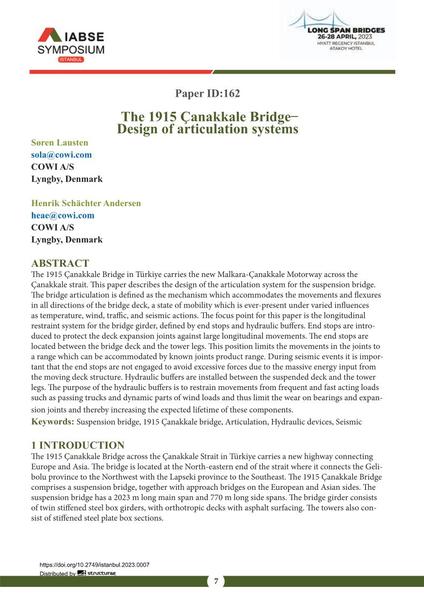The 1915 Çanakkale Bridge ̶ Design of articulation systems

|
|
|||||||||||
Détails bibliographiques
| Auteur(s): |
Søren Lausten
(COWI A/S, Lyngby, Denmark)
Henrik Schächter Andersen (COWI A/S, Lyngby, Denmark) |
||||
|---|---|---|---|---|---|
| Médium: | papier de conférence | ||||
| Langue(s): | anglais | ||||
| Conférence: | IABSE Symposium: Long Span Bridges, Istanbul, Turkey, 26-28 April 2023 | ||||
| Publié dans: | IABSE Symposium Istanbul 2023 | ||||
|
|||||
| Page(s): | 7-13 | ||||
| Nombre total de pages (du PDF): | 7 | ||||
| Année: | 2023 | ||||
| DOI: | 10.2749/istanbul.2023.0007 | ||||
| Abstrait: |
The 1915 Çanakkale Bridge in Türkiye carries the new Malkara-Çanakkale Motorway across the Çanakkale strait. This paper describes the design of the articulation system for the suspension bridge. The bridge articulation is defined as the mechanism which accommodates the movements and flexures in all directions of the bridge deck, a state of mobility which is ever-present under varied influences as temperature, wind, traflic, and seismic actions. The focus point for this paper is the longitudinal restraint system for the bridge girder, defined by end stops and hydraulic buffers. End stops are introduced to protect the deck expansion joints against large longitudinal movements. The end stops are located between the bridge deck and the tower legs. This position limits the movements in the joints to a range which can be accommodated by known joints product range. During seismic events it is important that the end stops are not engaged to avoid excessive forces due to the massive energy input from the moving deck structure. Hydraulic buffers are installed between the suspended deck and the tower legs. The purpose of the hydraulic buffers is to restrain movements from frequent and fast acting loads such as passing trucks and dynamic parts of wind loads and thus limit the wear on bearings and expansion joints and thereby increasing the expected lifetime of these components. |
||||
| Mots-clé: |
pont suspendu
|
||||
